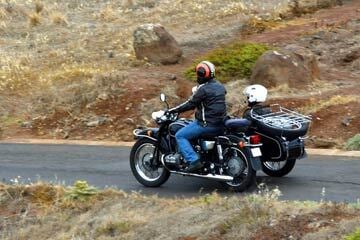Just like with cars, motorbikes over 3 years old need an annual MOT test to make sure they're safe and roadworthy. If you're caught riding without a valid MOT certificate, you could face a fine of up to £1,000.
Our checklist can help you do some routine maintenance on your ride so you can pass the motorcycle MOT first time.

What is a motorcycle MOT?
A motorcycle MOT is a test that's carried out once a year to check that your motorbike meets legal riding standards. You need to take your motorbike to an approved MOT test centre near you.
This is different from a service, which is essentially a health check to make sure the motorbike's running smoothly. The bike MOT is a legal requirement, checking critical safety features like:
- Brakes
- Steering
- Lights, mirrors and electrics
- Wheels, tyres and suspension
- Structure and attachments, including the exhaust and fuel systems
- Exhaust noise
Do I need a motorbike MOT?
Yes, you need a valid MOT for your motorbike. Just as with cars, most motorbike types over 3 years old need to have a valid MOT certificate. So you need to get it tested once a year to make sure the motorbike is roadworthy and fit to ride.
You can see whether your motorbike needs an MOT by using our MOT status checker.
If you do need a bike MOT by law, you could be fined £1,000 if you're caught without one.
Without an MOT certificate, your motorbike insurance is likely to be invalid.
Motorcycle MOT checklist
The motorcycle MOT consists of 16 checks to ensure your motorbike is safe and fit for purpose.
Your bike is checked for any damage, excessive wear and tear, and that it meets government standards.
You can see the full list of motorbike checks at GOV.UK.
While all this might seem a little daunting, there isn’t much on the MOT itself that you can’t double-check before test day.
Here’s a list of some of the most common motorbike MOT failures and what you can do to prepare.
1. Headlamps and lights
Lighting and signalling issues are the top reasons for motorcycles failing their MOT, accounting for 41% of MOT failures.
The tester should look at:
-
Whether the lights actually work
-
Their condition
-
If they're fitted with the correct colour headlamps
-
If all headlamps are aimed correctly
You can check all of this yourself, potentially saving yourself from failing your MOT straight away.
2. Steering and suspension
The condition, security, and operation of these parts are examined.
The tester should pay particular attention to the:
-
Forks
-
Handlebars
-
Head bearings
-
Swinging arm
-
Shock absorbers
You can check these before the MOT yourself. Raise the front wheel off the ground and move the handlebars from lock to lock, making sure they turn freely.
Then grab the forks at the bottom and attempt to push and pull on them. Any movement could suggest looseness in the head bearing.
Move to the rear and bounce the bike to make sure the suspension is working as expected.
Then grab each swingarm end and try to move it around. If you can, this could be a sign that your swingarm bearings need replacing
If you've noticed any of these potential faults, or any difference in the handling of your motorbike, you should consider getting these problems fixed before the MOT.
3. Wheels and tyres
Your MOT tester will investigate the condition of the wheels and tyres.
This includes whether the right size/type has been fitted to the motorbike, and the tread depth.
For motorbikes over 50cc, you need at least 1mm of tread across three-quarters of the width of the tread pattern.
There must also be the correct alignment between the front and rear wheels.
4. Frame and seat
The motorbike’s frame should come under scrutiny to ensure that it’s free from cracks, damage, distortion or corrosion. This is to make sure that it isn’t suffering from any conditions that could affect either the steering or braking.
The tester should also check that your seat is attached securely.
Other attachment checks include:
-
Whether the motorbike should have footrests that should be securely fitted
-
Checking that the clutch lever isn’t damaged
-
Checking that the drive chain isn't too worn and should have a guard for security
5. Brakes
The brakes themselves must be operational and perform as expected.
Test them yourself by applying the brakes and making sure the wheels can rotate freely when you release the brake. Also check that the brake pads aren’t worn.
The tester will look at the:
-
Disc brakes
-
Brake pads and shoes
-
Brake hoses
-
ABS warning lights, if applicable
6. Exhaust and fuel system
The motorbike’s exhaust system needs to be complete, secure and as quiet as possible.
The fuel system must also be secure and not have any leaks.
7. Sidecar (if fitted)
If your motorcycle has a sidecar fitted, the tester should examine whether:
- It’s attached and aligned securely and properly
- The suspension is working
-
The lights are working
-
The tyres are in good working order
-
The wheel bearings and alignments are correct
Other things to do before you take your bike for its MOT:
- Clean your motorbike. In particular, your registration plates should be readable and in good condition. Plus cleaning your bike will mean it's easier to spot if anything's worn, loose or missing.
- Documentation. Make sure the motorcycle's vehicle identification number (VIN) matches the VIN in the log book.
- Check your oil. Your oil usually needs to be changed every 3 months or 3,000 miles, whichever comes first.
- Test your horn. This needs to be audible.
What are some common motorcycle MOT fails?
According to DVSA figures, around 15% of motorbikes failed their MOT test in 2023-24. While this is better than other types of vehicle, failing your motorbike MOT could leave you £30 worse off.
The most common motorcycle MOT failure was lamps and reflectors, making up 41% of all faults found.
The full list of failures are:
- Lights and reflectors - 41%
- Brakes - 18%
- Structure and attachments - 11%
- Suspension - 10%
- Tyres - 9%
- Steering - 6%
- Identification of the vehicle - 4%
- Wheels - 1%
- Horn - <1%
How much does the motorcycle MOT cost?
It costs £29.65 for a motorcycle MOT and £37.80 if your motorbike has a sidecar.
Note that these are maximum costs. You may be able to find a cheaper motorbike MOT garage, so it's worth shopping around.
There are 2 different classes of motorbike for the MOT. Class 1 motorbikes have an engine up to 200cc, and class 2 motorbikes are over 200cc. The class your motorbike is in doesn't affect the maximum price you pay for the motorcycle MOT.
| Class | Vehicle Type | Maximum MOT fee |
|---|---|---|
|
1
|
Motorcycle (engine size up to 200cc)
|
£29.65
|
|
1
|
Motorcycle with sidecar (engine size up to 200cc)
|
£37.80
|
|
2
|
Motorcycle (engine size over 200cc)
|
£29.65
|
|
2
|
Motorcycle with sidecar (engine size over 200cc)
|
£37.80
|
How long does a motorbike MOT take?
A motorcycle MOT usually takes about 45 to 60 minutes. But if it fails for any reason, it'll need to be repaired and retested. If this happens, it could take quite a bit longer.
For this reason, it's best not to rely on having your bike back swiftly if it's in for an MOT. You never really know if it might fail for a reason you haven't picked up on
What isn’t checked in a motorcycle MOT?
Not everything is checked in an MOT. It’s about seeing if the motorbike is roadworthy and passes certain legal checks. It’s not a full service of your ride.
The following usually isnt looked at during a motorbike MOT:
-
The engine
-
The clutch mechanism
-
The gearbox
How is the motorbike MOT graded?
Any defects or issues identified by the tester is given a grade.
The motorbike MOT grades are:
- Dangerous: Direct risk to drivers or damages the environment, meaning the motorbike isn’t road legal. This will fail the MOT.
- Major: Issue must be repaired immediately. This will fail the MOT.
- Minor: Defect isn’t a significant risk, but should be repaired as soon as possible. This doesn't usually fail the MOT.
- Advisory: Issue needs to be monitored and acted upon when needed. This doesn't fail the MOT.
- Pass: Reaches the legal standard of safety.
Do I need a moped MOT?
A moped, defined as a 50cc motorcycle that can’t exceed 30 mph, still needs an MOT.
But there are some differences when it comes to the MOT inspection for your moped:
- It's not mandatory for your moped to be fitted with indicator lights
- There’s no minimum tread depth for the tyres
- A registration plate is only needed on the rear of your moped
Does a classic motorbike need an MOT test?
If your motorbike is more than 40 years old and no substantial changes have been made in the last 30 years, it doesn’t need an MOT.
Substantial changes include replacing the chassis, body, axles or engine to change the way the vehicle works.
If you’ve made modifications to your motorbike, you need to tell your insurer, too.
So if you’ve got a classic motorbike, chances are it won’t need an MOT.







